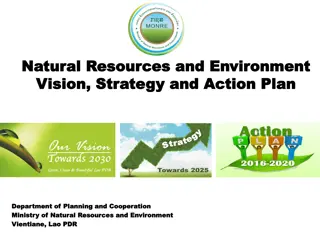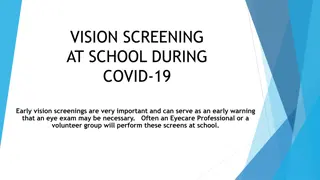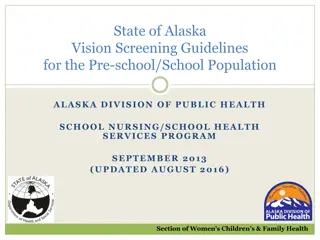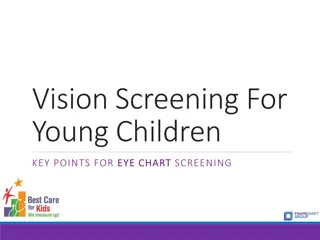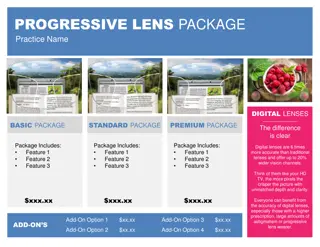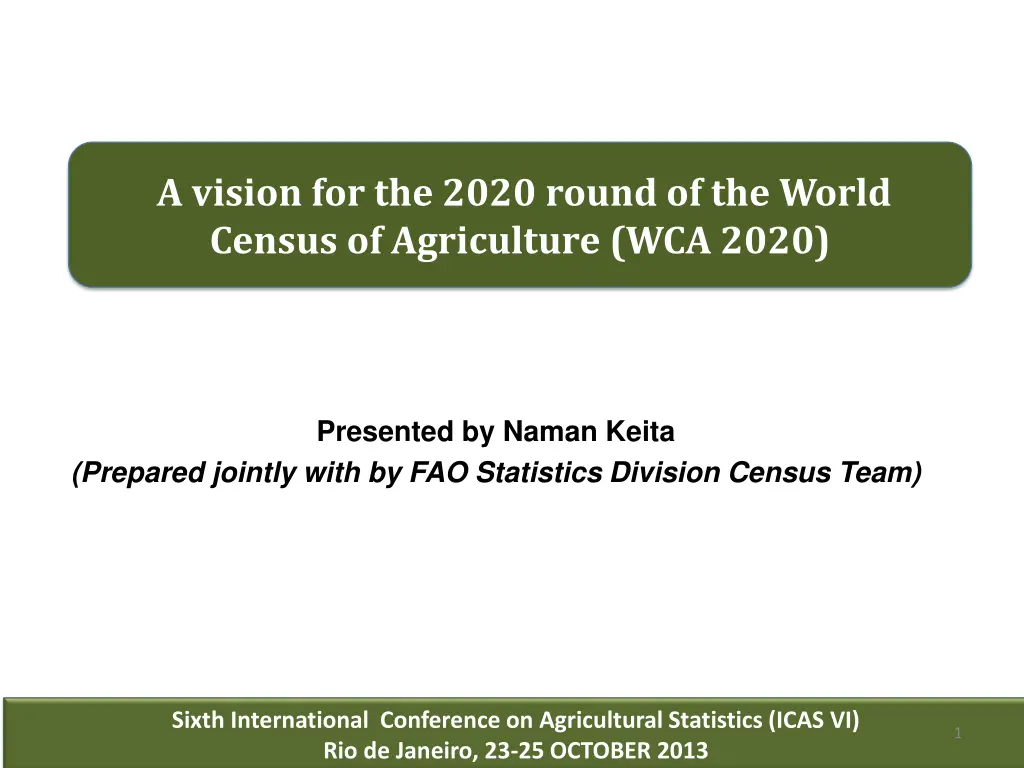
World Census of Agriculture 2020: Vision & Overview
Explore the importance of the World Census of Agriculture 2020, its structure, data collection process, and the role it plays in shaping agricultural policies globally. Get insights into the proposed content, supplementary guidelines, and the development process for WCA 2020.
Uploaded on | 1 Views
Download Presentation

Please find below an Image/Link to download the presentation.
The content on the website is provided AS IS for your information and personal use only. It may not be sold, licensed, or shared on other websites without obtaining consent from the author. If you encounter any issues during the download, it is possible that the publisher has removed the file from their server.
You are allowed to download the files provided on this website for personal or commercial use, subject to the condition that they are used lawfully. All files are the property of their respective owners.
The content on the website is provided AS IS for your information and personal use only. It may not be sold, licensed, or shared on other websites without obtaining consent from the author.
E N D
Presentation Transcript
A vision for the 2020 round of the World Census of Agriculture (WCA 2020) Presented by Naman Keita (Prepared jointly with by FAO Statistics Division Census Team) Sixth International Conference on Agricultural Statistics (ICAS VI) Rio de Janeiro, 23-25 OCTOBER 2013 1
Outline of the presentation 1. What is a census of agriculture & why is it needed? 2. Background on WCA and FAO Role 3. Censuses of Agriculture in new environment 4. The Census of Agriculture as a Component of an Integrated Agricultural Statistics System 5. Lessons learned from WCA2010 and possible new approaches to conducting agricultural census 6. Proposed content of Programme 7. Supplementary guidelines 8. Process of development of WCA2020 9. Some issues for discussion guidelines WCA 2020 2
1. What is a Census of Agricultural and why is it needed ? What is a census of agriculture? o A census of agriculture is a large-scale statistical operation for collecting, processing and disseminating data on the structure of agriculture, covering the whole or a significant part of the country, o Typical structural data collected in a census of agriculture are: size of holding land tenure land use, crop area harvested irrigation livestock numbers labor and other agricultural inputs. o The word census in its traditional meaning implies a complete enumeration of all agricultural holdings; o However, in many countries, for various reasons, the census is conducted, completely or partly, by sample enumeration provided that the sample is large enough to generate sub-national data 3
1. What is a Census of Agricultural and why is it needed ? Why a census of agriculture is needed? A recent review of Canada s Agriculture Statistics Program Review concluded that : a complete enumeration of the agriculture industry (AC) is needed to meet the policy and program requirements of federal and provincial governments, industry and other key stakeholders . The AC is a unique source for the following key information: o Benchmarks for current agricultural statistics, in particular information about non-surveyed portion of inter-censal surveys o Sampling frames for agricultural sample surveys o Data for small and custom geographic areas o Data on rare and emerging commodities o Data for detailed cross tabulations. In addition, and for many developing countries, AC is the unique opportunity to mobilise and renew attention on agricultural statistics and build the capacity of statistical organisations by providing them with operational and technical survey equipment upgrading human capacity. 4
2. Background of WCA and FAO Role o A WCA round covers a period of ten years centred on a year ending with zero o Up to now, nine rounds of the WCA have been carried out since 1930 under the auspices of IIA and FAO: 2 rounds (1930 and 1940) under he auspices of IIA 7 rounds (1950, 1960, 1970, 1980, 2000, 2010) under the auspices of FAO The current round of WCA 2010 (2006-2015): 102 countries conducted so far, 42 planning o o WCA 2020 will cover 2016-2025 o For each WCA round, the FAO Statistics Division: Prepares and issues Guidelines Monitors and documents the censuses conducted during that round (serve as feedback for next WCA round) Prepares reviews of results and methodologies of the censuses conducted during the past round. 5
3. Censuses of Agriculture in New Environment New development agenda and emerging policy issues : Post 2015 and Sustainable Development Goals Interaction between agriculture and environment (Green growth) Rural employment and gender Food Security, productivity and sustainable agriculture rural development Growing importance of measuring impact of development policies and programmes Significant volatility that agricultural industry presently faces (as evidenced by 2008 food price crisis) o Expanding data requirement to address past and new issues in the 21st Century Basic data related to the structure of agriculture Emerging data requirements related to climate change environment, land and water use Data related to Food Security and Rural Poverty Global Partnership for Development data (Post 2015 process) etc o 6
3. Censuses of Agriculture in New Environment OPPORTUNITIES New Global initiatives in the area of Statistics Global Strategy to Improve Agricultural and Rural Statistics Agricultural Market Information System (AMIS) Bussan Action Plan for Statistics o Digital/mobile/geo information technology and data revolution Improved technology/reduced cost and growing use of for data collection remote sensing and tools such as PDA, GPS, CAPI o Resource constraints: Lessons to be learned from methodological and technological innovations in Population Census Agricultural module in population census Growing use of administrative records Combining complete enumeration with sample surveys Use of rolling pop-census which spreads data collection geographically over a 10-year time interval o 7
4. The Census of Agriculture as a Component of an Integrated Agricultural Statistics System The growing and diversified data requirement call for an integrated agricultural statistics system: Censuses of agriculture Periodic surveys: annual, multi-annual, ad-hoc Administrative data Other sources The census of agriculture will be one of the sources and will focus on: structural data small/custom geographic areas Rare or emerging commodities Benchmark annual agriculture survey program estimates Building frame information for the survey program Socio-economic data on farm households Emerging data suitable for Census (to be defined) 8
5. Lessons learned from WCA 2010 and new approaches Lessons learned from implementation of WCA2010 suggest that some of the features remain relevant (regional consultations and country practices): Modular approach with more details on implementation modalities Linking population and agricultural census Community level data Sub-holder concept in some regions New approaches to consider: Intensive use of new technology where applicable Use of complementary sources: registers, farmers associations, cooperatives, etc..) Intensive use of sampling combined with complete enumeration Rolling Census? 9
The agricultural census in the framework of an integrated system of censuses and surveys & modular approach Household food security Land Irrigation Aquaculture POPULATION CENSUS CENSUS CORE MODULE CENSUS SUPPLEMENTARY MODULES Crops Farm labour IN-DEPTH AGRICULTURAL SURVEYS Agricultural practices Livestock
6. Proposed content of guidelines WCA 2020 Programme Methodological issues oConcept of agricultural holding and how to capture cultivated forestry aquaculture agricultural service activities oHow to include the land not managed as part of the holdings (community land, land under water, etc.). Different approaches used by different countries. oImproving methods for collection of gender disaggregated data and role of women in agriculture: Is the concept of Sub-holding and Sub-holder relevant and how best to operationalize it? 11
6. Proposed content of guidelines WCA 2020 Programme Data items It was requested to add or revise data items to meet new emerging needs, including (by theme): o Agricultural practices Organic farming Farm Management Practices Conservation agriculture Crop rotation practices Fertilizers used by crops Livestock mang t practices (e.g. SAPM in Eurostat) o Agricultural labour force Data on child labour On-farm and off-farm employment (income) for social protection o Income sources and key factors of production, disaggregated data for: land management ownership of productive assets access to services land ownership resources generated from farm 12 Eurostat SAPM: Survey on agricultural production methods
6. Proposed content of guidelines WCA 2020 Programme Data items to add or revise (cont d) o Aquaculture aquaculture facilities aquaculture inputs (feed, machinery) oData for frames for ad-hoc surveys Pre/post harvested wastages Disposal of harvest: seed, feed, wastage Extraction rates and processing efficiencies for on farm activities Cost of production surveys Surveys on use of forests and non wood forest products o Other data needs mentioned Family farming and small holder agriculture Urban agriculture Climate change 13
6. Proposed content of guidelines WCA 2020 Programme Classifications Classifications need revision to harmonize with new international standards (SEEA, CPC v2, HS) o Land use classification Consistency with SEEA, IPCC, FRA Further breakdown of the category of otherland (SEEA: buildings, protected land, aquaculture land) o Crop classification Adding aquatic plants Expand coverage to aromatic, medicinal and narcotic plants Mapping to CPC o Machinery and equipment classification To cover hand tools (Important for developing countries) To cover post-harvest machinery Breakdown by age and capacity of big machinery (important for estimation of capital formation) Mapping to HS 14
6. Proposed content of guidelines WCA 2020 Programme Issues on census data collection, processing, dissemination and analysis oAdditional guidance requested on: Potential use of administrative data to reduce cost for census taking Use of new technologies (PDA, GPS, CAPI) for collecting census data Analysis and use of census data in conjunction with other data sets Gender analysis Analysis of structural transformation and farm typologies Other tabulations for thematic studies o Archiving and access/dissemination of micro data =>The WCA Programme, however, will focus on the methodology and than on practical guidance for conducting the census. 15
7. Supplementary guidelines o The main guidelines for WCA 2020, will focus on the conceptual and methodological recommendations. Additional guidelines will be prepared to provide practical guidance for conducting the census. Possible themes include: Implementation of modular approach and use of sampling Integrated survey framework Building Master Sampling Frames Use of administrative datato reduce cost for census taking Use of new technologies (PDA, GPS, CAPI) for collecting census data Analysis and use of census data in conjunction with other data sets Archiving and access/dissemination of micro data 16
8. Process of development and timeline for WCA 2020 Plan for Consultations, Validation and Endorsement Activity Period Consultations Internal consultations at FAO Ongoing External consultations: countries, experts, int l organizations Ongoing Methodological review Methodological review of ag-census in Asia-Pac, Africa, Americas, Europe Ongoing Prioritize recommendations and lessons learnt Sep-Oct 2013 Technical papers Discussion papers in regional & international meetings: AFCAS, IICA, ICAS-VI, IAGFS (2013), APCAS, UNSC (2014) Ongoing Writing Concept note and draft workplan Jul 2013 Annotated outline for WCA2020 and technical roles assigned Nov-Dec 2013 Preparation of 1st drafts of the Guidelines and other volumes (conducting census, processing, analysis, etc.) 2014 17
8. Process of development and timeline for WCA 2020 Plan for Consultations, Validation and Endorsement Activity Period Validation Peer review of draft WCA 2020: countries, experts, int l organizations, regional and intern l meetings Late 2014 Adoption by governing bodies: UNSC, FAO 2015 Publication and dissemination Revision, edition, layout and publication 2015 Dissemination seminars 2016 onwards 18
8. Process of development and timeline for WCA 2020 The Planned Review Process for the Programme o The different themes, core items and classifications will be reviewed and updated with the help of experts in each subject- matter o The needs expressed during consultations will be prioritized o New data needs (including those from Global Strategy) will be covered to the extent possible o Non-essential changes should be avoided as countries that have collected some of these data elements in WCA 2010 will not want to lose the benefit of historical comparisons. 19
BRAZIL Use of PDA equipped with GPS for Ag Census
MOZAMBIQUE Data collection using CAPI for Ag Census
9. SOME ISSUES FOR DISCUSSION ON WCA2020 o APPROACHES PROPOSED? oCONTENT? oPROCESS? oPOSSIBLE AREAS OF COLLABORATION? 22
THANK YOU! http://www.fao.org/economic/ess/ess-wca/en/ 23







